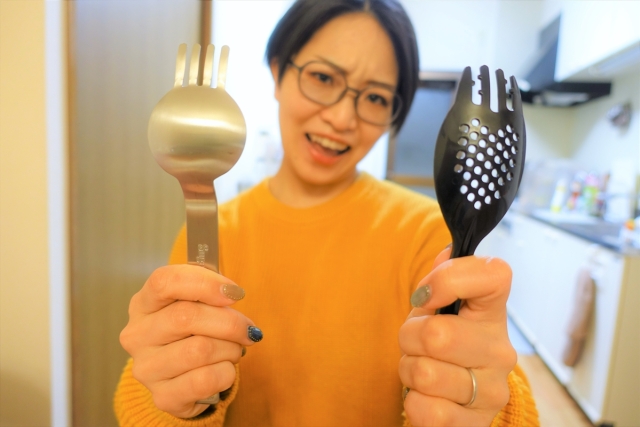
High-performance spork action.
Spork innovation has been advancing at a steady pace. Prototypes date back to the latter half of the 19th century and it’s design was revolutionized by the ramen chain Sugakiya in the latter half of the 20th century. Sadly, “steady” does not equal “rapid,” but when it comes to sporks the phrase “if it ain’t broke don’t fix it” surely applies.
However, now at 100-yen store Daiso, the Scoon may very well be the next evolution in spork technology, and half a century early! At only 110 yen (US$0.95) after tax, its value is matched only by the mystery of why it’s called “Scoon.”
My best guess is that it’s a rather freewheeling portmanteau of “spoon” and “cup noodle,” because the package explains that it is ideal for the close quarters of instant ramen with its serrated prongs and perforated spoon section. It was also created by Kokubo Kogyo, a company that has earned its stripes in the 100-yen game with a line of quality products at rock-bottom prices.
Scoon certainly has a lot going for it, but to really earn its stripes, it’ll have to go toe to toe with the old guard: the Sugakiya spork.
▼ Scoon (left), Sugakiya spork (right)
By positioning the prongs on the exterior of the spoon rather than interior, the Sugakiya spork achieved a totally new level of balance between soup and noodle. For completely changing the way ramen is sporked, this utensil even earned the acclaim of the Museum of Modern Art in New York City.
Epoch-making utensils don’t come cheap, however, and an official Sugakiya spork costs 1,980 yen (US$17) after tax. That might be more than many are willing to spend on sporks, so the question our reporter Haruka Takagi is setting out to answer is if the Scoon provides a cost effective – or dare we say better – ramen experience than the Sugakiya spork.
This was sure to be a raging hot battle, so Haruka prepared an instant cup of raging hot ramen from the famous Mokotanmen Nakamoto chain.
The tension in her kitchen became excruciating during the soup’s mandatory three-minute soak, as the two spork challengers coldly stared each other down.
The defending champion was allowed to go first and Haruka took a big dip with it into the paper cauldron of capsicum. Unsurprisingly, the champ fished out a hearty clump of noodles for her to feast on.
And after that she was able to skim a veritable abyss of crimson soup with the Sugakiya spork’s securely concave surface.
Because of that, the full force of Mokotanmen Nakamoto’s spicy ramen hit her square in the VR1 receptors. It was a spine-tingling blend of agony and ecstasy.
▼ Haruka: “Oooooh”
The Sugakiya spork wasn’t without its faults, however. It was rather heavy for a utensil and can cause an unpleasant sensation when hitting the teeth for some people. If she had to be completely honest, it could stand to hold more soup per scoop too.
So, the stage was set for Scoon to impress, and impress it did with an even more bountiful haul of noodles!
Haruka was afraid that they would slip off the Scoon’s plastic prongs, but the serrated edges held strong and steady for a very comfortable eating experience.
It was at this time that she realized a critical mistake that she had made. One of the Scoon’s strong points was its perforated bottom, which might look like a disadvantage at first, but actually enables it to pick up those tricky, tiny toppings like cabbage and mystery meat that often elude our grasp and end up at the bottom. If a spoon such as the one on the Sugakiya spork were to attempt to scoop up such tasty debris, it would likely float on the surface and easily spill back out with the slightest jostle. This problem is solved with Scoon because as the broth drains through the holes it pulls those topping down with it. Those same toppings then fill the holes which would hold the broth in place as well.
This is how it should work in theory, but the Mokotanmen Nakamoto cup ramen, while delicious, was very light on such small items and didn’t give Scoon a chance to shine like a Cup Noodle might have. We shouldn’t hold that against Scoon though, and ought to give it credit for that feature.
So, throughout the first half of the cup ramen, Sugakiya spork and Scoon were pretty much neck and neck in terms of overall performance. However, as Haruka approached the bottom of the cup a clear winner had emerged.
It appeared as though the shorter handle and longer scooping part of the Scoon made it very hard to pick anything up from the lower half of the cup.
The Sugakiya spork, on the other hand, continued to deliver hearty spoonfuls and forkfuls of ramen well into the cup’s twilight moments.
And that was the end of this match up, The Sugakiya spork’s acclaimed designed won the day once again. With its short but effective prongs and ergonomic design it provided the better ramen experience hands down.
However, Scoon held its own incredibly well and at nearly one-twentieth of the cost. Haruka was also left wondering if the result wouldn’t have gone a different way had Scoon be given the chance to shine with a more topping heavy ramen.
Scoon definitely brought some important innovations to sporks, but in the end may need some fine tuning to become the next chapter in the technology. Luckily, they still have another 40 or 50 years to get it sorted out.
Photos ©SoraNews24
● Want to hear about SoraNews24’s latest articles as soon as they’re published? Follow us on Facebook and Twitter!
[ Read in Japanese ]